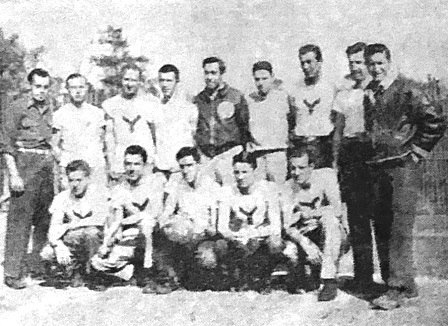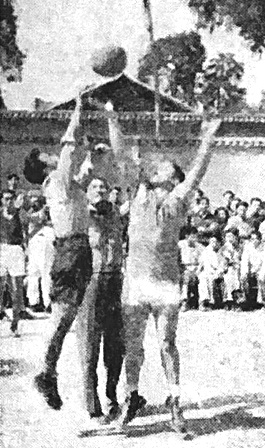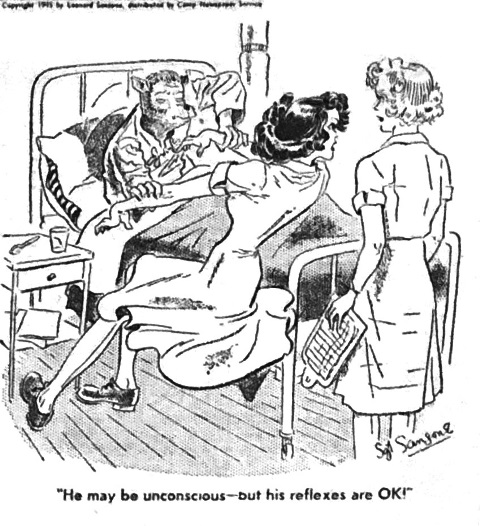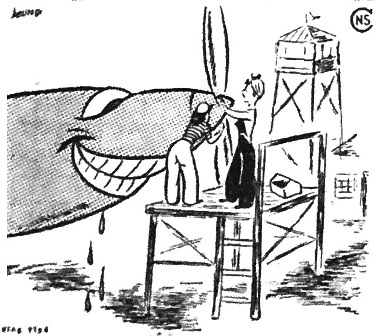
|
|
|
China Chief Sees
14th AF, SOS, CTC
Visiting southwestern China early this week, Generalissimo Chiang Kai-shek had as his hosts a number of high-ranking American officers including Maj. Gen. C. L. Chennault, commanding general, Fourteenth Air Force; Maj. Gen. G. X. Cheves, commanding general, Services of Supply, CT; and Col. John W. Middleton, commanding officer of the Chinese Training Center.
Addressing Gen. Chennault and the staff officers of the headquarters, Air Service Command, ATC and combat wings of the Fourteenth, the Generalissimo said:
"You have established in the past few years an enviable record and have dealt severe blows to the enemy."
"I have come here particularly today to greet you in person and to offer thanks for the good work you have done."
Later the Generalissimo visited the SOS headquarters of Maj. Gen. G. X. Cheves and discussed some of the supply problems linked up with military operations in China. Cheves reaffirmed his determination to be of assistance wherever possible.
At SOS, the Generalissimo also met Col. Mason H. Lucas, chief of staff of the Chinese SOS, and Lt. Col. A. J. Gricius, chief of staff, USF, SOS, CT, as well as other members of the two staffs.
At the Chinese Training Center, the Generalissimo paid high tribute to U.S. Army personnel for teaching modern methods of warfare to Chinese soldiers. He said that results of the teaching are already evident and that American training will inevitably bring about the defeat of the common enemy.
The Generalissimo was welcomed to the Chinese Training Center by Col. John W. Middleton.
Among CTC installations visited by the Chinese leaders were the General Staff School, the Infantry Training School and the Interpreters School.
Wearing a military cape over his smartly cut uniform, the Generalissimo impressed all the Americans at the Chinese Training Center with his soldierly bearing, but surprised many of the "Maygwaws" with his afficable, democratic manner. He stopped to pose for pictures for GIs as readily as for the official Signal Corps lensmen covering the inspection trip.
One GI who asked him to "hold it" while he snapped a close-up of the smiling 'Gissimo exclaimed: "Why, he's as good a scout as Jinx Falkenburg!" Which is about the highest praise any individual can receive from an American soldier in China.
Following his visit to the Chinese Training Center, the Generalissimo returned by plane to Chungking.
 Brig. Gen. Albert F. Hegenberger, chief of staff, Fourteenth Air Force, the Generalissimo, and Maj. Gen. C. L. Chennault.
Brig. Gen. Albert F. Hegenberger, chief of staff, Fourteenth Air Force, the Generalissimo, and Maj. Gen. C. L. Chennault.
|
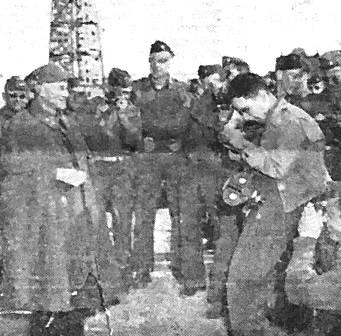 GI and officer camera fans train their lenses on the distinguished visitors.
GI and officer camera fans train their lenses on the distinguished visitors.
|
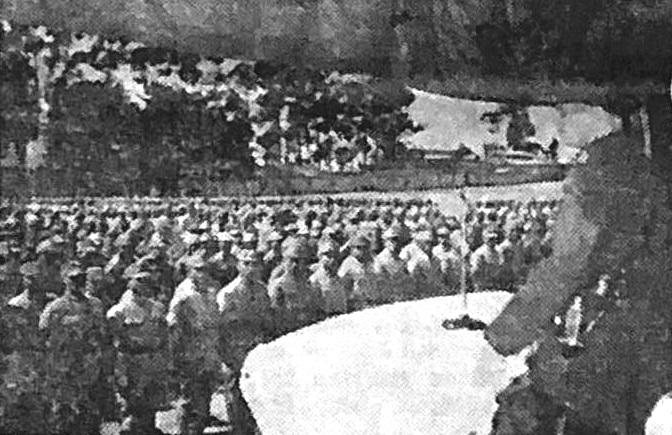 Addressing a portion of the new student volunteer army.
Addressing a portion of the new student volunteer army.
|
CHINA REPS TO ’FRISCO LISTED
CHUNGKING, March 29 - China will be represented at the San Francisco Conference by ten delegates, including the Foreign Minister Mr. T. V. Soong, the Ambassador in London, Dr. Wellington Koo, the Secretary General of the Supreme National Defence Council, Wang Hung Hui, the Ambassador in America, Mr. Wie Tomang Taorming, a former Ambassador to America, Mr. Hu Shih, and Mr. Hu Liu, member of the 1944 goodwill mission to Britain.
Leaders of the Chinese National Socialist Party and the Chinese Youth Party and one communist, and also Miss Wu Fiyang, president of Gingling College have been included in the delegation. Mr. Alfred Sze, ex-Ambassador to America has been appointed senior adviser.
SOUTH YUNNAN SECRET CHINESE ARMY
PLANS OFFENSIVE
|
KUNNMING, March 29 - A secret army commander whose name can not be revealed but who is described as "one of China's ablest generals" has been put in charge of the Chinese armies stationed "somewhere in southern Yunnan."
Some of China's best armies, including veteran units which fought from Tairchwang to Hanknow are now grouped under his single command here.
Gen. Ho Yingchin, chief of the General Staff of the Chinese Army, and Maj. Gen. Robert B. McClure, Commanding General of Chinese Combat Command, have just been touring this area and it is disclosed that at one point they were within 15 miles of the French Indo-China border. No details of their tour have been made public for reasons of military security but it may be said that they covered about 850 miles travelling in jeeps, trains, on horseback and on foot.
It is understood that the tour had been planned long in advance - before the recent Japanese move to disarm the French and Annamite troops in Indo-China - but what the two generals have seen or heard will certainly have bearings on offensive plans they have made or may make for the future. Wherever Gen. Ho Yingchin and Gen. McClure went they tried to drill confidence into the minds of the Chinese soldiers who have for so long facing a better equipped foe. The Chief of the Chinese General Staff told them "only offensive can lead us to victory - we must prepare now for the task ahead."
It is without question that the secret general's command is assuming importance never before felt so keenly as today in view of developments in the Pacific and on the south border. His troops there guarding "China's sidedoor" are earmarked to receive some American equipment already in China and are now being reorganized and trained in modern warfare technique in preparation for the day of full battle.
Chinese SOS Names 7 Area Commanders
HQ., CHINESE SOS, KUNMING - Rapid progress in the organization of the field force of the Chinese Services of Supply is being made, it was indicated this week when Maj. Gen. G. X. Cheves, commanding general of Services of Supply for U.S. Forces in China, announced appointment of seven Area Chinese SOS Commanders with approval of Gen. Ho Ying-chin, supreme commander of Chinese Forces.
The Chinese SOS was organized only a few weeks ago with headquarters here as an integrated organization of Chinese and American officers and enlisted men to develop a modern supply system for the Chinese Army.
Several advances have already been made in food program, transportation, and the adaptation of American methods to many Chinese Army supply problems.
The seven Area Commanders of Chinese SOS appointed include Maj. Gen. Chen Yin-chi, Lt. Gen. Chen Yao-shien, Maj. Gen. Chang Nai-heng, Maj. Gen. Chiang Jui-ching, Lt. Gen. Tuan Keh-chang, and Col. Wang Tse-chen.
Most of the Chinese SOS Area Commanders will have American deputies and associates to carry the integrated organization into the field forces.
Details of the headquarters and field organization of Chinese SOS are being worked out largely under the direction of Col. Mason H. Lucas, chief of staff, who holds the equivalent rank of major general in the Chinese Army.
|
To Hospital Head
Aleksie A. Leonidoff, Poughkeepsie, N.Y., commanding officer of a station hospital near Kunming, was promoted from lieutenant colonel to colonel this week, it was announced by the commanding general, China Theater.
Since his assignment as commanding officer of the station hospital, Col. Leonidoff has been outstanding in his supervision and planning of the rapidly expanding facilities there.
The Russian-born Col. Leonidoff was graduated from the Moscow University Scholl of Medicine in 1916, and upon graduation accepted a commission as captain, and became medical officer of a field artillery unit. After serving a four-year hitch he was discharged as a lieutenant colonel.
Coming to the United States, he set up medical practice in Poughkeepsie, N.Y. and took training courses in specialized fields of medicine. He later accepted a commission in the Army of the United States as a major in the Medical Corps and in less than a year's time was promoted to the rank of lieutenant colonel.
Upon coming overseas in February, 1944, he was assigned as Medical Advisor to the Chinese Troops with the "Z" Forces. For his work with this command he has received the Bronze Star, the Certificate of Distinguished Service from Generalissimo Chiang Kai-shek, and the "Spirit of Co-operation" Medal from a Chinese Artillery unit.
Military Bypass Road Around Kunming Goes Into Operation
|
KUNMING - The wife of the Chief Engineer, Madame Lin, cut the red ribbon and the ceremonial convoy rolled through, signalling the opening of the eight-kilometer Kunming bypass, the first exclusively military road in China, at a formal ceremony last week.
The bypass will be used exclusively by convoys and Army traffic over the Burma Road to get to the depots and ordnance shops without the necessity of passing through the crowded streets of the city.
The road, which skirts the northern part of the city, passing outside segments of the ancient stone wall of Kunming, was built in one month by the Eighth Construction Office, Engineering Commission of the Chinese National Military Council, headed by Mr. Charles Lin.
Guest of honor at the formal opening was Maj. Gen. G. X. Cheves. Col. Joseph S. Gorlinski, theater engineer, Lt. Col. Ernest W. Everly, Maj. Martin A. Nicholas and Capt. Thomas H. Hopkins, all of the Corps of Engineers were decorated with flowers by the small daughters of Chief Engineer Lin.
At a dinner party given by the Eighth District Engineers in the Kunming Tennis Club following the bypass opening, Gen. Cheves congratulated the engineers and said that the target date of March15 for completion of the road had been set by Lt. Gen. A. C. Wedemeyer, theater commander, and assured the Chinese engineers that Gen. Wedemeyer will be pleased to know they met the target date.
"This accomplishment by Chinese engineers proves that you can meet a goal or target date," said Gen. Cheves, "and if all our forces can meet the target dates set up in our planning, we will hasten the day of a real offensive."
Guests were entertained with a Dragon drama outdoor and dancing.
|
Bronze Stars To CACW Personnel
HEADQUARTERS, A COMPOSITE WING, WESTERN CHINA - Seven officers and enlisted men of Brig. Gen. J. C. Kennedy's Composite Wing headquarters were awarded Bronze Star medals recently in a formal ceremony at a Fourteenth USAAF base in China. All men receiving awards had been active in field work during the Salween campaign.
Maj. Claude C. Hockley, Jr., Portland, Ore., Capt. Robert I. Standish, San Bernardino, Cal., and Capt. Jack Pancake, Miller, Ohio, were air party officers in charge of the air-ground coordination activities between Chinese troops in the field and Maj. Gen. C. L. Chennault's Fourteenth Air Force planes.
Sgt. Ralph J. Mehle, Reading, Pa., Sgt. Theodore M. Freedmen, Brooklyn, N.Y., Sgt. Frank F. Greene Jr., Los Angeles, Cal. and Sgt. Edward F. Roessler, Cincinnati, Ohio were communications men who operated in front line dugouts during the offensive.
Citations accompanying the awards stated that each of these officers and non-commissioned officers had performed outstanding service in assisting aerial operations against the Jap from the time Chinese units crossed the Salween river until the fall of Tengchung.
M/Sgt. John P. Hanrahan, Providence, R.I., and T/Sgt. Charles H. Hoyle, Tallassee, Ala., both veteran members of the "Spray and Pray" squadron of the Chinese-American Composite Wing were awarded Bronze Stars recently for meritorious achievement on the ground.
Both men fly combat missions in B-25 Mitchell bombers in addition to performing extremely responsible ground crew jobs. M/Sgt. Hanrahan is communications chief for the squadron and T/Sgt. Hoyle is armament chief.
M/Sgt. Hanrahan supervises the maintenance of the radio equipment and instructs Chinese radio operators, and T/Sgt. Hoyle handles the meticulous job of instructing Chinese ground crew personnel in the proper loading and handling of bombs and ammunition.
59 CCC Officer Promotions Listed
CHINESE COMBAT COMMAND - Orders promoting 59 Chinese Combat Command officers on duty in the field and three serving at Hq., CCC, have been received by Maj. Gen. R. B. McClure, commanding general, CCC, from the China Theater headquarters of Lt. Gen. A. C. Wedemeyer. The order promoted the following:
From captain to major: James E. Beacon, Jr., Omaha, Neb.; Grant E. Bolton, San Antonio, Tex.; Ralph R. Camien, Wichita, Kans.; Uriah M. Clemmer, Jr., Midway, Tenn.; James M. Cullison, Charleston, Mo.; Charles J. Curtin, Clarks Summit, Ga.; Austin A. R. Dyson, Urbana, Ill.; John F. Gordon, New Brunswick, N.J.; Albert D. Goudreau, Kalamazoo, Mich.; Gail W. Haut, Bronx, N.Y.; James G. Henrick, Topeka, Kans.; Walter C. Hodnett, Jr., Atlanta, Ga.; Franklin J. Holmes, Olamen, Me.; Peter S. Hopkins; Milton Horowitz, Elizabeth, N.J.; Eric C. Kinsey, Jr., San Francisco, Calif.; Cecel D. Laidlaw; Howard A. Lowry, Peoria, Ill.; Harold E. Massingale, Greenville, S.C.; George L. McQueen, Roseburg, Ore.; Russell D. Nolte, Hudson, Mich.; John F. O'Grady, Jr., Richmond, Va.; Richard L. Parker; Robert F. Podlich, Severna Park, Md.; Elwin R. Prather, Eureka, Kans.; Carl F. Raab, Washington, D.C.; Bert Relnow; Jerome H. Ross, Los Angeles, Calif.; Cecil I. Sinkler, Kalamazoo, Mich.; Darbing L. Skogstrom, Chicago, Ill.; Victor L. Stedronsky, Leland, Miss.; Edmund D. Taylor, Atlanta, Ga.; Frederick E. Van Tassell, Oakland, Calif.; William H. Van Loan, Buffalo, N.Y.; Ben H. Ward, Athena, Tenn. and Arthur F. Wilkerson, Marion, Ala.
From first lieutenant to captain: Isadore N. Axelrod; Richard Ducker, Tecumseh, Okla.; John D. Haynes; Morton W. Kiger, Glendale, Calif.; Manuel Kwon, Honolulu, T.H.; Patsy M. Liguori, Walton, N.Y.; Milton S. Meyer, New York, N.Y.; Beaven W. Mills, New York, N.Y.; Daniel M. Schaeffer, Newark, N.J.; Kenneth G. Stohlmann, St. Louis, Mo. and Earl A. Waller, Lancaster, Pa.
From second lieutenant to first lieutenant: William P. Boswell, Cincinnati, O.; Gene A. Flaherty, Austin, Tex.; Robert E. Grant; Joseph A. P. Lamothe, Providence, R.I.; Henry A. Langheim, Waverly, Ill.; Joseph T. Lee, Jr.; Llyod C. Long, McAlester, Okla.; Robert K. Riel, Muskogee, Okla.; Wesley R. Sampson, Fulton, Mo.; Henry L. Sawaski; William F. Thompson, Aurora, Ore.; Edward A. Tyburski, Schenectady, N.Y.; Spencer C. Valmy, New York, N.Y.; Charles L. Young, and Jack T. Young, New York, N.Y.
“HATCHET MEN” SAVE 14th AF CARGO PLANE
Quick thinking on the part of a crew in a troop carrier squadron of the Fourteenth Air Force saved a transport from destruction and possibly saved the lives of everyone on the plane.
The plane was on a dropping mission and started the return flight with sufficient gasoline to reach the home base. Adverse weather conditions forced the pilot Lt. Glover E. Philbrick, Glendale, Calif., to turn back and fly off course for a long distance and as a result the gasoline was running low.
Part of the freight aboard the plane consisted of two drums of gas and after the crew conferred on the subject, Lt. Philbrick ordered the aerial engineer, Corp. Vernon S. McKee, Brentwood, Mo., to get the "crash axe" and chop a hole through the floor of the plane and into the gas tanks so that the gasoline could be poured from the drums to the tanks. The co-pilot, Lt. Milton C. Woodson, Marinette, Wis., who formerly worked on the construction of the same type transport knew just where to chop the hole in order to make contact with the gas tanks.
Corp. McKee aided by Lt. Herbert J. Adams, Navigator, Tampico, Ill., succeeded in chopping the hole through the floor and into the tank. The gasoline was poured into the tank and a short time later the plane landed at a friendly air base.
Quick thinking and a hole in the floor and gas tanks saved thousands of dollars worth of Air Corps equipment.
Warm Welcomes Extended To Stilwell Highway Drivers
KUNMING - Travel-weary GIs, drivers of vehicles coming into China over the Stilwell Highway, have been awe-stricken by the top brass on hand to meet them, as well as the enthusiastic and hospitable welcome they received from officers and enlisted men ranging from Maj. Gen. G. X. Cheves, to the members of the mess hall staffs here at SOS headquarters in Kunming.
Since the first vehicles began arriving in February, the personnel of Special Service, the American Red Cross, Area Command, the Theater Band, and even the local Military Police detachment have pitched in to make things as pleasant as possible.
Truck drivers and mechanics of the convoys have high praise for the members of "G" mess hall staff who have labored far into the night to prepare a feast of fried chicken and ice cream when they pulled into town. Mess sergeant at "G" mess hall is S/Sgt. Anthony L. Canonica. He is assisted by Sgt. Victor A. Picarello, Sgt. Paul J. Domagala, Sgt. John Arloff, Sgt. Allen Cheatwood, Corp. Frank Franchino, Corp. Kenneth G. Betty, Pvt. Andrew J. Shedlock and Pvt. Raymond Hernandez.
Red Cross clubmobile girls extended the hand of hospitality to the vehicles bringing vitally needed war materials to China. Mrs. Helen McCormack and Miss Veronica Heck met several of the convoys miles out of town with heaps of doughnuts and steaming coffee.
Ice cream, a treat to the folks back home these days, was prepared by S/Sgt. Robert Stock, mess sergeant at "K" mess hall and his staff, and Sgt. Leroy Barclay made most of the cakes for their parties.
For nearly two months now, the China Theater Band, a group of hard working GIs who "double in brass" by working in offices during the day and playing their instruments at night, has met the convoys, rain or shine. The band, directed by T/Sgt. Paul Tompkins, has played two or three hours at the mess halls after putting in a hard days work themselves. Members of the band are S/Sgt. Lloyd Lunham, S/Sgt. Roy Wilde, Sgt. Paul Neighbors, Sgt. Howard Williams, Sgt. Harold W. Harris, Sgt. Conrad Taylor, Sgt. Henry Evens, Sgt. Ralph Fetherolf, Corp. Arthur Flanders, Corp. Simon Silberg, Corp, Richard Wynn, Corp. John Sulkin, Corp. Irving Robin, Corp. Clifford Taylor, Corp. Glenn Lloyd, and Corp. John DeJulius.
Other entertainers at the dinners, and special entertainment features given for the drivers included a harmonica band, composed of Corp. Forrest G. Scott, Corp. Donald Sanders, and Pfc. Charles Lucas.
Special Service officers and enlisted men on hand to welcome the vehicles included Capt. Alfred Plant, T/Sgt. George Montgomery, and Corp. Harold "Happy" Harris.
|
|
by GEORGE H. JOHNSTON |
...Custodian Of China’s Culture

|
Today there are modern military installations around the ancient walls of Ch'eng-tu, and troops of the Generalissimo's army train in assault operations across the rivers and streams that Marco Polo admired. Huge airfields have been carved out of the fertile plain where the Mongol hordes in conquering this present province of Szechuan claimed to have put 1,400,000 persons to the sword at the order of the Grand Khan. But inside its towering walls and beyond its massive horned gates Ch'eng-tu remains almost unchanged by wars and centuries, still the center of much of modern China's culture, still the home of ancient crafts handed down from father to son for countless forgotten generations.
|
In the narrow, twisting streets of polished cobblestones wander the tribes people from the little known territory that stands like an impregnable barrier between mediaeval China and forbidden Tibet. Oil lamps glow behind the red paper windows of the little shops, unchanged since the day of Marco Polo where the tap-tap-tap of the silversmiths' hammers echo far into the night, and where women bend low in the dim illumination over the famous embroidered pictures on the rich silk of Szechuan and where the pincers are snipping briskly on the fine drawn silver wire that will be used for the delicate filagree jewelry of old Ch'eng-tu. In this ancient city the present, and the future, outwardly seem less important than the past.
The Nestorian Christians had a monastery in Ch'eng-tu twelve centuries ago - Marco Polo makes no mention of their survival five hundred years later and they were probably all destroyed in the fierce persecutions that occurred in Ch'eng-tu and Sian before 1000 AD. It was in 883 AD that printed books were first discovered in the booths along the streets of Ch'eng-tu... history's first record of the printing of books. Fine printing paper was available in Ch'eng-tu a thousand years before it was known in Europe. Perhaps it is more than accident that today, as a millennium ago, Ch'eng-tu is the magnet and haven for the culture that remains to a China bled by war and defeat. For, just as the refugees of the T'ang dynasty flocked from Shensi to Ch'eng-tu 1,000 years ago, so has the ancient city absorbed a great spate of refugees from the east in the eight bitter years of struggle in modern China.
Where before the war Ch'eng-tu had one university, the famous National Szechuan University, now it has seven, for six others, among them some of the greatest institutions of learning in China, took part in the great westward migration of culture and settled down for the duration in or near Ch'eng-tu. Many of the lesser colleges of China have also come to this ancient seat of Chinese culture - and today it has much of the flavor of old Pekin, with its antique charm, and its red-lacquered doorways and moon gates, and walled houses with the willows sagging over from hidden courtyards, and its young, eager students strolling down the narrow streets or walking the ancient gardens or browsing through the books in the little shops of the academic center of Hua Si Pa or sitting in the shadowy Szechuan teahouses, discussing their ambitions or reshaping the world as university students have done since the beginning of higher learning. Sometimes they sprawl with their books on the green lawns of the vast campus of the compound stretching towards the modern Chinese buildings, or watch the brown and white university cows stolidly cropping the green grass. Most of China's university students of today are poor, their poverty reflected in their shabby long gowns of faded blue cotton. Few wear western clothes, and they, too, are shabby.
|
This faded shabbiness is not confined to the students. It is the motif of the old city of Ch'eng-tu itself. Where Yunnan has massive scarred mountains and a violence of red earth and indigo sky and a landscape of gigantic dimensions. Ch'eng-tu has a placid understatement of time, space and color. Even the vividly checkered fields of emerald rice and canary-colored sesame do not have the richly pigmented violence of Yunan, for the soil is usually a neutral grey, and a pearly greyness is almost always in the sky, and the colorful fields extend back to grey mountains, misty with distance. Inside its high square walls, the city of Ch'eng-tu is a city of aged grey stone and faded red walls, and in the fields the houses are white, with the criss-cross black half-timbering that awakens vision of old thatched Tudor cottages. Through the hills are scattered the black clumps of tea bushes and between terraced farmlands stand little brick kilns of pink stone, kilns that are operated exactly as they were two thousand years ago.
In many of the things makeup the Ch'eng-tu Plain - one of the richest agricultural areas of the earth - there is a strange, easy timelessness that makes the centuries seem like yesterday.
South of the city, at Tzu Liu Ching, are salt mines that have been worked without interruption, and with practically no change of technique for 1,500 years. Far below surface level there are limitless subterranean lakes of brine, which are drilled up as oil is drilled, and the liquid is run down bamboo sluiceways and distilled over jets of flame from natural gases in the earth.
Everything in the factories is made of bamboo, except the boiling pans, and mechanical power is supplied by blinded oxen making their endless plodding circles. It is a family industry, for it takes at least a generation and a half to drill one well, and many a Chinese workman at Tzu Liu Ching will labor for a lifetime so that his sons and grandsons will have profit when he is dead. Some years ago an American engineer saw these primitive salt works, smiled a little pityingly and went away to form a syndicate to develop the salt deposits by modern methods. For two years he competed with the 1,500-year-old industry before his firm went bankrupt. He had been beaten by the past. The Chinese produced more salt and produced it more cheaply. He gave up . . .
To the north of Ch'eng-tu lies the ancient farming center of Kuan-hsien, last real settlement of Western China, and terminus of little know caravan route from mysterious Eastern Tibet and Sikang. It is so close to the massive mountain barrier that half the town area which is enclosed within a crumbling crenellated wall stands almost perpendicular on the mountainside, and the road to forbidden Tibet actually runs from the center of the town, through a high walled gate and straight into the soaring mountains. Surging down from there Tibetan hills, almost alongside the city wall comes the
|
It is undoubtedly in the glittering waterways of the Min River spreading out from Kuan-hsien that we find the main reason for the lasting importance and fame of Ch'eng-to. Through the centuries its tempo has neither increased nor slackened, and although it is a mass of incongruities, steeped in medievalism and yet constantly swept by tides of modern thought, Ch'eng-tu remains essentially unchanged.
In the teashops, at the high rostrums in the distant corners, the old story-tellers, with operatic intonations and dramatic gestures, recount the old folk tales and myths and legends that were told when Marco Polo passed through with only the minor embellishments and alterations that time has given. The minstrel singers pluck the strings of their moon guitars as they sing the ancient ballads of China, as did the wandering minstrels and bards of Europe a thousand years ago. And alchemists sit in darkened booths surrounded by their wares - mummified snakes coiled in rich silk, dried toads' skins, cups made from rhinoceros horns so that they will sweat if poison is poured into them.
And the cries of the street peddlers and the whining of the beggars; the clanging cymbals and clattering catenas of the food vendors; the metallic beat of the silversmiths' hammers; clacking of silk looms and the high-pitched twanging of the cotton fluffers; the cry and laughter of children and the cackling amusement of the oldsters; the padding shuffle of the coolies trundling their wheelbarrows or shambling beneath sedan chairs; the distant tolling of a temple bell; the crowing of a cockerel, and the timeless whisper of the countless feet that have worn the stones of Ch'eng-tu to a brilliant gloss.
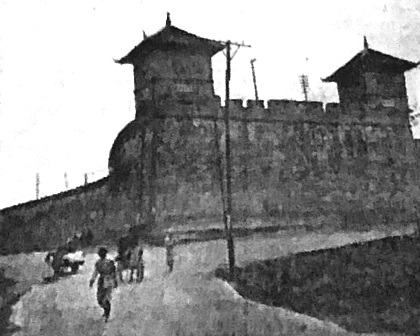 CH’ENG-TU CITY WALL in the north-west part of the city.
CH’ENG-TU CITY WALL in the north-west part of the city.
|
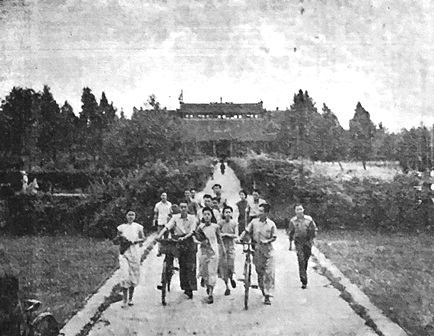 STUDENTS ON THEIR WAY TO CLASSES at the refugee Nanking University in Ch'eng-tu.
STUDENTS ON THEIR WAY TO CLASSES at the refugee Nanking University in Ch'eng-tu.
|
Soldiers sit in the cafe discussing military strategy or the course of the war in Kiangsi and Hunan. Students wander down the ancient street arguing about Anton Chekhov and Schopensuer and Confucius and Karl Marx. The shrill vibrant blare of an automobile horn can scarcely drown the squeakness, the ancient squeakness, of the unoiled wooden wheels of the oxcarts.
And in that atmosphere, where time is little more than a fourth dimension, one suddenly realizes that there would be no sense of surprise if a tired Venetian wanderer his Tartar robes dulled by dust, strolled slowly down between the leaning timbered houses and shops, no surprise in knowing that this was Messer Marco Polo himself come back to Sin-din-fu.
|
To All-China Cage Champions
Added importance was lent to the All-China Basketball Tournament, to be played at the "Hangar" at APO 627 on the weekend of April 6, 7 and 8, with the announcement from the Theater Special Service Office that the theater's ranking generals will present trophies to the winners and runners-up, in addition to individual awards to outstanding players.
The winners of the cage tourney will receive the "Gen. Wedemeyer Trophy," emblematic of the basketball championship of China; the runners-up will receive the "Gen. McClure Award," and the players on both of these teams will receive individual awards.
Gen. Chennault will present the "Chennault Award" to the cager adjudged the "Outstanding Player" by the Awards Committee, on the basis of all-around playing ability and leadership, and the Gen. Cheves Award" will go to the tourney's "Best Sportsman."
Every effort is being made by the awards committee to have the Generals themselves on hand Sunday night, April 8, the final night of the tournament, to present their awards in person, but should business prevent the awards will be presented by a member of their staff immediately following the final game.
In addition it has been announced that banners are being secured and will be presented to all the team in the tournament as a memento, and testifying to their standing as one of the theater's outstanding teams.
Definite entries have been received by the Tournament Committee from the Kunming "Cagers," the SOS "Sharpshooters," the ATC "Commandos," the CTC "Snipers," the AACS "Signals," and teams have been assured from the Yangki, Chanyi, Yunnanyi, and Kweiyang areas pending outcome of elimination tourneys in those areas to assure the entrance of the outstanding team or group of players.
In the meantime progress on the physical fixtures for the tournament has been reported by the committee. The hardwood at the "Hangar" will be reconditioned, the lighting checked, and the general playing facilities will be in perfect condition for the games.
From the spectator standpoint everything will be done to assure the top enjoyment of the games.
|
‘FALCONS’ FIVE - Tentative acceptance of a berth in the All-China Basketball Tourney has been extended to the APO 212 "Falcons." All former college and university players this quintet was the winner of a recent weekend tournament at the Hangar, APO 627. The players, left to right, front row: Capt. George Velan, Chicago, Ill., U. of Ill.; Lt. Robert C. Perry, Crystal City, Mo., Mo. School of Mines; Lt. Richard Barody, Geneva, N.Y., Rochester; Lt. Frank Belot, Greenville, S.C., Toledo U. and Lt. Ed Waite, Seattle, Wash., U. of Wash.
Rear row, left to right: Lt. E. Krobot, St. Louis, Mo., manager; S/Sgt. Richard Hutton, Auburn, Neb., Peru State Teachers; S/Sgt. Winfield Tobey, San Diego, Cal., S.D. State Teach. College; Lt. Fred Carey, Hartford, Conn., Dartmouth Univ.; Lt. G. E. Doyle, Wash., D.C., coach; Lt. W. E. Smith, Lakewood, Ohio, Baldwin-Wallace U.; Sgt. Leo Locher, Linton, N.D., N.D. State; Lt. James Carey, Hartford, Conn., Amherst U. and Leibik, Chicago, Illinois.
Cagers Snap AACS Win Streak 31-28
In one of the most bruising games of the season, a contest that was decoded in the last two minutes, the Kunming Cagers upset the previously undefeated AACS Signals 31-28 Saturday night at the "Hangar" in APO 627.
The capacity crowd of better than 1,500 cage fans were in a constant uproar as the lead see-sawed back and forth in the contest in which quarter was neither given nor received. Tenacious guarding featured the contest, and neither of the high-scoring teams had many opportunities for good shots.
The Cagers jumped out to a 10-3 first quarter lead as Freschone cut through for two baskets, Schall dumped a one-hander from the side, Wolfe tapped in a rebound, and Schall and Felice added free throws, while the Signals were unable to use their usual set plays against the Cagers man-to-man defense.
The Signals began to hit in the second period and piled up 12 points in a rally sparked by Crawford, Maceau and Knapp, while holding the Cagers to two baskets, to lead 15-14 at the halfway mark. The Cagers offense was upset midway in the period by the loss of Schall via the personal foul route.
The both teams matched point for point in the third quarter and the score was 23-22 in favor of the Signal as the last ten-minute period opened.
The last quarter opened with both teams at a white heat. The Signals dumped a set shot to go ahead 25-22 their biggest edge in the game, but Felice cut down the margin with a pivot shot. Knapp gave the AACS five a two-point margin after netting a foul shot, but Wolfe cut through for a layup to knot the count at 26-26.
With four minutes left in the game Maceau netted a one-hander to put AACS in the lead once more, and Purcell twisted in a left-hander for
|
In the opening game of the twin-bill The Ramblers topped an Ordnance five 58-41, with Paulsen and Beckman braking fast out of the Rambler's zone and netting 18 and 16 points respectively. Bradford with 14 and Shortt with 13 were top men for the Ordnance quintet.
Kunming U. Five Beats ATC 41-36
HQ., CHINA WING, ATC - Depleted by the loss of their outstanding players the ATC Post basketball team lost to the South-Western University of Kunming, China 41 to 36, before a large gathering of Chinese students at the spacious academy field house.
The Chinese quintet proved the master throughout the fray with the victory never in doubt until the final period, when the ATC quintet put on a desperate spurt to bring the count to 37 to 34, with two minutes remaining in the period. But the University five smashed right back when Lye sank a set shot from mid-court and Fung a layup to put their team in a safe lead with a half-minute to go.
At half-time the South-Western University basketeers led 20 to 12.
The college five used a pick-up man to man defense, with their center always remaining backcourt. No set-up plays or strategy was utilized. Their agility and fast driving layups carried them to victory over the ATC team.
Charlie Lye playing like a veteran stateside star topped the winners for scoring honors with seventeen points on eight field goals and one free throw. Joe Wung also paced his teams attack with twelve points.
For the ATC squad Pfc. Lewis Bass who played a smart floor game throughout and Pvt. "Tom" Collins netted 12 points each for the losers.
The games was replete with speedy action from the start to the final whistle, and there were frequent spills because of the spirited play.
|
WASC Helps Lower 'Hump'
Tonnage Feeding U.S. Forces
HQ., SOS, KUNMING - Feeding American forces in China is a job that the Chinese themselves have undertaken to save manpower and hump tonnage.
The War Area Service Corps, organized as a branch of the National Chinese Military Council in 1937, with Maj. Gen. J. L. Huang, as director-general, now operates 90 messes in various parts of China and employs in this operation, plus the procurement of foods, transportation, and in some cases growing of vegetables, a total of about 12,000 Chinese youth.
"We do not have to bring cooks to China, and other types of American personnel for these special subsistence tasks," said Maj. Gen. G. X. Cheves, commanding general, Services of Supply, China Theater.
"In extending military aid to the Chinese we are trying to gain efficiency by using every available source of manpower in China. We are integrating our forces and developing teamwork wherever possible."
The Chinese boys in WASC man the hostels, provide the hot water, clean the rooms, do the laundry, take care of bedding, wait on tables, serve in kitchens, and operate abattoirs where cattle and hogs are butchered to provide food for the GI tables.
In the earlier days the WASC furnished not only all the food but kitchen utensils, bedding, charcoal fuel, electricity, toilet paper, soap and candles. Some of these items, however, now are furnished by SOS, and the Army also brings in a few food items such as canned milk, coffee and butter from overseas.
In addition the WASC operates barbershops where soldiers get haircuts and shampoos at very low prices, it publishes a news bulletin daily in mimeograph form which is distributed to the hostels, and it runs an Interpreters' School from which young college boys among the Chinese are graduated and furnished to the American forces where required.
The United States Forces in China are unique among those in all theaters of the war because they get the bulk of supplies by airlift over the "hump" of the Himalaya mountains and also because they live largely off the land. Food imports to China are very small.
Food is procured from China's farms by the WASC. Their trucks scout areas for 100 miles from important bases to buy meat, fuel, vegetables, eggs, flour, lard, sugar, and they go into many markets to buy salt, soy beans, peanuts, walnuts, noodles, pepper, tea and baking powder.
During one recent month the cost of food purchases by WASC was CN $27,198,160. Despite this figure in inflated Chinese currency, the job is a tremendous task.
|
Now Worth School Credit
By Camp Newspaper Service
This is addressed to servicemen and women everywhere, but primarily to those who plan to return to school after the war.
You can earn academic credit, while still in service, not only for satisfactorily completing courses offered through the facilities of the United States Armed Forces Institute, but also for a wide variety of military training and experience.
Even your basic training has an educational value, in the opinion of leading American educators. So have the various courses offered by Army and Navy schools. Army and Navy specialized training and actual experience handling a Service job.
USAFI officials and leading American educators have devised certain guides and procedures designed to assure every serviceman and woman a fair evaluation by U.S. schools and colleges of his military training and experience and of off-duty educational studies.
The plan seeks to avert the mistakes made following the last war, when accreditation for military training and experience was hap-hazard, "hit-or-miss," and often on a simple "even-stephen" basis - so much credit for so much time spent in service. Under this arrangement, some men got more credit than they deserved and some got less.
Keystone of the new plan is a handbook published by the American Council on Education, worked out in co-operation with the National Department of Secondary Schools Principals, the great regional accrediting associations, the Army Education Branch in the Information and Education Division and the corresponding agencies in the Navy, Marine Corps and Coast Guard.
This booklet contains descriptions of the hundreds of training courses in the Armed Services - objectives, content, time allotment and admission requirements. It also contains the judgements of educational experts on the appropriateness of accepting the course for credit in different types of civilian school or college programs. Published in up-to-date looseleaf form, it will be in the possession of practically all high school principals and college officials. With the handbook for ready reference, educators will be ably readily to interpret and evaluate applications for credit from military personnel and need have only an accurate and reliable statement from the applicant.
in order to facilitate the handling of such applications, USAFI has worked out a method whereby military personnel can apply directly to the schools or colleges of their choice for credit, with assurance of a speedy and fair evaluation.
Servicemen and women are urged to make application while still in service, because the action by the schools and colleges on their applications will provide a guide to the courses or studies they should pursue through USAFI or in off-duty classes in order that they may resume their education

|
Personnel whose post-war educational plans are indefinite should submit credit applications to the school or college they think it most likely they will attend so that an official record of their military training and experience will be available if needed.
A new application form, "Application For Credit For Educational Achievement During Military Service," (USAFI Form No. 47, revised September 1944) has been devised for this purpose. Every I and E officer should have this form.
Upon receipt of the form, the educational official at the school will study the facts shown in it, check them against his own records in the American Council Handbook and in relation to the diploma requirements of his own school, and determine the kinds and amounts of credit to which the applicant is entitled.
In most instances, the educator will be able to make this decision promptly and without requiring more information. In some cases, however, it may seem desirable to suggest that the applicant take certain USAFI examinations in order to supply additional evidence of his educational status or competence.
The educator will report the examinations desired to USAFI, which will send them directly to be administered locally by the certifying officer. The results will be returned immediately to USAFI, which will grade the examination papers and report the grade received to the school or college for use in determining credit.
|
Sgt. George V. Fenton co-christener of the "China Lantern," is the editor, publisher and one-man staff of "The Clarion," daily newssheet of the Golden Tigers squadron. Fenton specializes in radio-fresh news from the world's battlefronts. He simulates actual newspaper makeup by typing the news in column form and topping each story with hand-printed headlines.
MASONS TO VISIT BLIND GIRLS EASTER SUNDAY
KUNMING - Kwei Chu Hui, the Square and Compass Club of Army officers who are Master Masons, will visit the School for Bling Girls operated by Lutheran Sisters on Easter, April 1, at 3:30 p.m. The reconstructed school building which the Masonic group has helped to make possible will be formally opened on Children's Festival, April 4.
ENGINEER TO ADDRESS KWEI CHU HUI CLUB
KUNMING - Mr. Peter Eardley, civilian engineer who has spent many years in China will address the regular meeting of the Kwei Chu Hui following dinner in Red Cross Town Club on Monday, April 2, at 2:30 p.m. All officers of American and Chinese forces who are Master Masons are invited.
KUNMING MASONIC CLUB MEETING ON APRIL 4
KUNMING - Next meeting of the Kunming Masonic Club, composed of enlisted men of U.S. Forces who are Master Masons will be held in the Hotel du Commerce, Tuesday, April 4, at 7 p.m.
|
REQUIEM MASS HONORS MEMORY OF
HEROS OF YUNNAN-BURMA CAMPAIGN
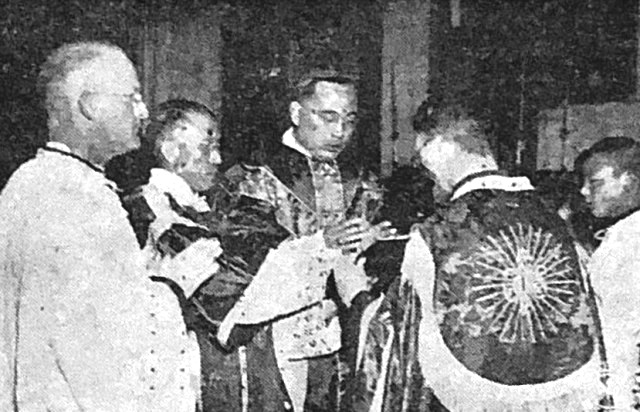 BISHOP PAUL YU-PIN reading the opening prayers at a Requiem Mass for Allied soldiers and civilians killed in the campaign to open the Stilwell
Highway. The mass was held at Ste. Therese Cathedral, Kunming. Left to right are Fr. Lawrence Curtis, Baltimore, Master of Ritual; Fr. Simon Suen, deacon
of the mass; Bishop Yu-pin; and Fr. Paul Yu, sub-deacon.
BISHOP PAUL YU-PIN reading the opening prayers at a Requiem Mass for Allied soldiers and civilians killed in the campaign to open the Stilwell
Highway. The mass was held at Ste. Therese Cathedral, Kunming. Left to right are Fr. Lawrence Curtis, Baltimore, Master of Ritual; Fr. Simon Suen, deacon
of the mass; Bishop Yu-pin; and Fr. Paul Yu, sub-deacon.
|
KUNMING - Solemn requiem mass was celebrated in Ste. Therese Cathedral here last week by Bishop Paul Yu-pin in memory of Chinese, American and British soldiers and civilians who lost lives in the Yunnan-Burma campaigns to open the Stilwell Highway.
A catafalque draped with flags of three nations was guarded by American and Chinese soldiers.
Bishop Alesandro Derouineau of Kunming participated in the ceremonies at the catafalque. Present were civil representatives of American, Chinese, Dutch, British and French governments. Brig. Gen. Henry A. Barber, Jr., Washington, D.C., deputy commander of Chinese Combat Command, and Lt. Col. Camden C. Fortney, Jr., Charleston, W. Va., of the Burma Road Engineers, officially represented those American units which were active in the campaign leading up to the opening of the road.
Bishop Yu-pin speaking in Chinese said the "services for the souls of those who shed their blood on the Yunnan-Burma front is an answer to their prayer that they be not forgotten." He said many of those died with none to comfort except the strength that they were doing their duty.
His words were echoed in English by the Rev. Louis J. Benoit, SVD, Techny, Ill.
Lt. Gen. Yu Li-ming, Lt. Gen. Kao Chi-jen, and Maj. Gen. Gaston Wang represented Chinese Forces, and Wang Chan-chi, commissioner for foreign affairs, represented the Chinese civil government.
Assisting in the services were Fr. Andreo Majcen, arch priest; Bishop John A. O'Shea, Philadelphia and Kanchow; Msgr. Joseph Kerec, Chaotung; Fr. Simon Suen, deacon; Fr. Paul Yu, sub-deacon, and Fr. Lawrence Curtis, Baltimore, master of ceremonies.
Present for the ceremonies also was Lt. Col. Joseph P. McNamara, Runford, R.I., chaplain for China Theater, and several associate chaplains of U.S. Forces.
|
KUNMING - One of the main difficulties of liaison work in China is the fact that, contrary to common belief in the United States, there is no such thing as a 'Chinese' language. Numerous dialect from the different provinces make for considering hardship in understanding at conferences. A unique solution to this problem occurred at a recent conference attended by Maj. Stanton T. Langs, Highland Park, Mich., of the Civil Affairs office, Services of Supply. "A conference was being held between a number of officials who spoke either French, English, Mandarin or Cantonese," he relates. "It was with the greatest difficulty that each could make all the others understand what he had to say." "We had been wrestling with French, interspersed with Mandarin and English, when suddenly the conversation began to go to everyone's satisfaction - no more don't understand's, 'ne comprend pas,' or 'pu tung.' "After listening for several minutes, I realized that all were now talking in 'Latin,'" the major concluded. |
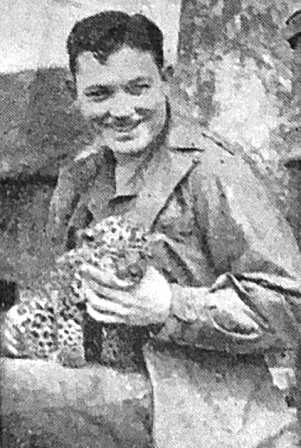 THE "FLYING TIGER" insignia has long been the emblem of Maj. Gen. C. L. Chennault's Fourteenth Air Force. Unable to find the tiger for a pet, Pfc.
Charles J. Cashen, Los Angeles, Cal., a member of an engineer unit attached to the CACW, settled for a young leopard. Raising it on a diet of dehydrated
milk, Cashen vows "I'll keep him until he grows too old - or too mean."
THE "FLYING TIGER" insignia has long been the emblem of Maj. Gen. C. L. Chennault's Fourteenth Air Force. Unable to find the tiger for a pet, Pfc.
Charles J. Cashen, Los Angeles, Cal., a member of an engineer unit attached to the CACW, settled for a young leopard. Raising it on a diet of dehydrated
milk, Cashen vows "I'll keep him until he grows too old - or too mean."
|
|
|

|

|
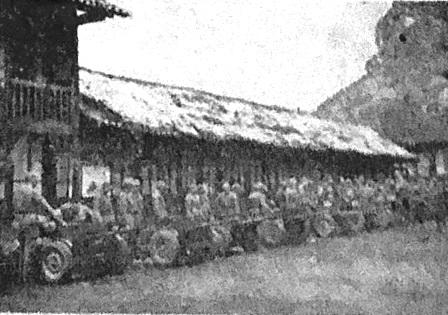
|
|
‘Point’ Grads Hold Traditional Dinner
HQ., 14TH AIR FORCE, CHINA - Throughout the years, in peacetime and during war, officer graduates of the United States Military Academy at West Point, hold a dinner on, or as near as possible to, St. Patrick's Day. On the night of March 17 the West Pointers of the Fourteenth Air Force in China, and the Army Ground Forces, with the exception of the men in the forward echelons, had their dinner in the King Pi Villa, Kunming, China. Rank, for the night, was forgotten, as colonels sat above generals who were in classes behind them at the Point. The old songs were sung and reminiscent tales of the past were retold as the war was forgotten for the evening. The honor guests included Lt. Gen. carton De Wiart, British Army, Maj. Gen. G. X. Cheves, commanding general, Services of Supply, and Brig. Gen. Albert F. Hegenberger, chief of staff of the Fourteenth Air Force. Col. W. J. Tack, an Infantry officer, Class of '14 was the toastmaster. S/Sgt. John F. Kosuta, Cleveland, Ohio, accompanied the singing on the accordion and a moving picture - The Army Football Team of 1944, was shown. Classes from 1914 to 1943 were represented. |
|
Eye Witness Stories At ARC News Sessions KUNMING - Soldiers in this area caught up on news developments of the week on worldwide fronts at "Analyzing the News" session in the Red Cross Town Club recently but in addition Maj. Gen. G. X. Cheves, commanding general of Services of Supply, brought them a couple of surprise visitors. Maj. John H. Lattin, Jamestown, N.Y., who has been through a lot of tough fighting in Northern Burma, and who confessed that it was the first time in more than 13 months that he had worn anything but fatigues or jungle battle-clothing, gave some first-hand reports on fighting for Myitkyina and pursuit of Japs towards Mandalay. The major said the toughest and longest march in a day was 21 miles covered in 23 hours. Theodore "Teddy" White, War Correspondent for Time-Life, Inc., who has been in China several years told the GIs a little about his trips into Yenan and operations of Chinese guerilla troops. He answered numerous questions with Gen. Cheves as master of ceremonies. |
|
‘China Junction’ ARC Club Opened A 14TH AIR FORCE, CHINA - They call it "China Junction" Club, and China Junction is exactly what it is - this air base Red Cross Club somewhere in frontier Free China. Recently three Red Cross girls and a gang of GIs pitched in to renovate and redecorate the Club. They held open house and Col. Paul D. Meyers, base commander from Dongan Hills, Staten Island, N.Y. held a tour of inspection. This is what the three Red Cross girls, Miss Hazel Brown, Frankfort, Ky., who is club director, Miss Matties Hodges, Bellevue, Texas and Miss Jean Brott, Marinette, Wis., both assistants, and the GIs did: All the main units - the central lounge, game room, library, coffee shop - were brightened up with paint, new draperies, new furniture. In this cheerful atmosphere the base personnel can relax, read, write to the folks back home, or just sit and talk over a cup of coffee and doughnuts. When the Red Cross girls and GIs finished their interior decoration job, the walls still looked a bit bare. So a photo unit put on the finishing touch by supplying pictures depicting base activities and the Chinese countryside. |
|
OWI Seeks GI Copy For Chinese Papers In response to request from Chinese publishers, the Office of War Information this week announced that they are seeking material on the American Army in China for release to the Chinese newspapers and magazines. The OWI will welcome articles or stories from any of the Army personnel who have a yen to see themselves in print - Chinese print. The OWI is particularly anxious to get short stories dealing with American Army life or combat operations in China, in addition to feature articles describing whatever phase of Army activity in this theater that you happen to know best. If your contribution is usable, the OWI will pass it through the theater PRO and the press censor, have it translated into Chinese, and submit it to the Chinese newspapers or magazines. If your copy is printed the OWI will send you a copy of the publication you have crashed. Whenever possible the author's credit will be printed in English as well as in Chinese, so that the people back home won't think that you are being a little careless with the truth. Contributions should be sent to the Feature Editor, USOWI, APO 627. Before sending any material, permission must be obtained to write for publication from your commanding officer, and the copy must be cleared through your local Public Relations Officer. |
|
CNAC ‘Hump’ Veteran Gives ARC Talk To GIs KUNMING - GIs at the Red Cross Town Club last Sunday heard some interesting facts about "hump flying" from Capt. G. A. "Robbie" Robertson, a CNAC pilot who has done more than 300 trips over the "ridge," to use his terminology. "Robbie" admits to being a Georgia "cracker" but said he was born in New England but soon transplanted to the vicinity of Macon. He got into "hump flying" by way of wing-walking and cute jumping for a barnstormer, then after soloing a while helping in the early days of the war to fly planes to Britain over the Atlantic, and graduating to the Himalayans. Col. Jesse C. Williams, A-2, of the 14th Air Force, was a guest and spoke briefly on "Security." Golden Tigers Squadron Conduct Post-War Talks Postwar conscious members of the Golden Tigers fighter squadron of Randall's Raiders have enlivened the weekly "orientation" sessions at their base by staging debates and open forum discussions relating to the problems of tomorrow. The progress is under the direction of Capt. Chaz M. Holland, executive officer, who chooses the topic of discussion each week from suggestions submitted by squadron members. Questions aired at recent meetings included: Postwar Prosperity, Compulsory Military Training and Demobilization. |
|
‘Falcons’ Open New ‘Roost’ At China Base AN ADVANCED BASE IN CHINA - Falcon Medium Bomb Group enlisted personnel officially opened their club, "The Falcons' Roost," this week, when they were hosts to all group officers at a cocktail party and a snack bar. Men who served the guests on opening night were: M/Sgt. G. R. Eiland, Jr., Munday, Texas; T/Sgt. R. K. King, Waterford, N.Y.; T/Sgt. Louis Macaluso, Hazelcrest, Ill. and S/Sgt. W. E. Kauffman, Princeton, Mo. The club was planned and constructed by enlisted personnel in the Falcon headquarters. It is decorated with knotty pine and appropriate pin-ups. It is furnished with overstuffed furniture, a radio, reading racks, and other available furniture. The club committee is as follows: M/Sgt. L. R. Pruitt, Commanche, Okla.; T/Sgt. J. A. Brennan, St. Louis, Mo.; S/Sgt. H. J. Ellis, Ada, Okla. and S/Sgt. J. Wieczorek, Greenwich, Conn. CHAPLAIN GIVES GIs COURSE IN CHINESE A one-man campaign to enrich the Chinese vocabularies of GI's stationed with the Randall's Raiders is currently being waged by Father William J. Glynn, chaplain of the West China fighter wing. Father Glynn offers a 20-lesson course in the Wade phonetic system with classes held six times a week at various bases. "It's just an elementary course in Mandarin," Father Glynn admits. "But all those who complete it will be able to converse fairly well in Chinese." |

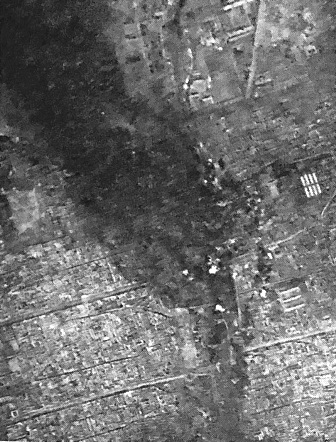
|

|
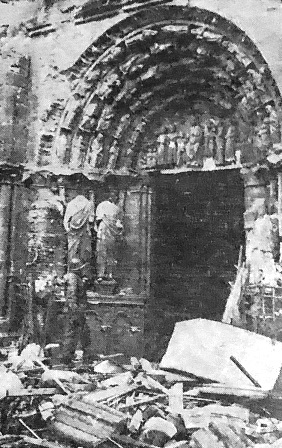
|
LEFT: SPIRALING SKYWARD, smoke from bombs dropped by 308th Bomber Group of the Fourteenth Air Force on Shihchichwang, Jap rail center on the Pin Han railroad to Peiping, on March 16. Nearly 75 tons of bombs, 65 percent of which landed within 1,000 feet of the aiming point, shattered the target. Heavy secondary explosions and fires followed. All planes returned.
CENTER: IDEAL RATION of underpin measurements puts starlet Andrea King at the top of the Warner lot in Hollywood as far as pretty legs are concerned. Hosiery designers voted on the King gams against such tough competition as Betty Grable and Eleanor Powell.
RIGHT: DESECRATION - Decapitated statues at entrance to Cathedral and massed debris below give evidence of fierce fighting in Trier. Raging battle preceded capture of German town by U.S. 3rd Army troops. Lone Yank stands at entrance atop pile of broken masonry and views destruction within. (Acme Photo by Charles Haacker for WPP.)
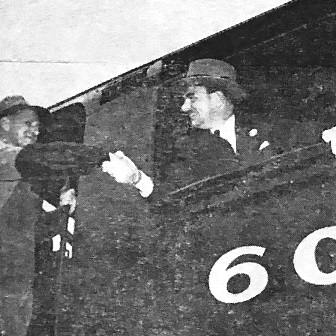
|
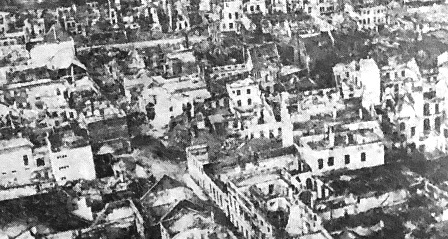
|
LEFT: SUPERSTREAMER - Gov. Thomas E. Dewey in driver's seat shakes hands with engineer John Peterson at official dedication of locomotive Niagara. Largest and most powerful ever built for New York Central, giant engine runs over 100 miles per hour. Train is first of series of 25 and is expected to affect post-war design of superstreamers.
RIGHT: INDUSTRIAL TARGET - Bombed from the air and shelled from the ground, most of the town of Neuss is in ruins. This aerial view of the west bank suburb of Dusseldorf shows remains of important industrial target on the Ruhr.
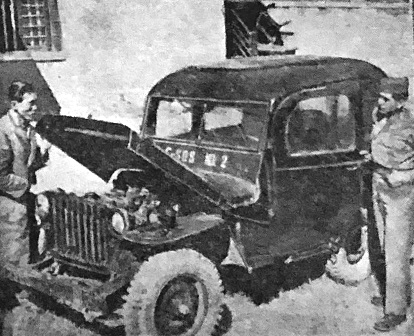
|

|
LEFT: POST WAR IDEA FROM CHINA - This army jeep may set a new style for GIs returning from the war. Chinese mechanics in Kunming fashioned a body and top for an ordinary jeep to provide an experimental car for monsoon driving above the clouds in mountainous country. S/Sgt. Jerry A. Jaramillo, Santa Fe, N.M., demonstrates the door mechanism while a Chinese mechanic lifts the hood, indicating its a real jeep.
RIGHT: GIDDUP - Without knowledge of how to say "Gee and Haw" in German, these Yanks aren't making out so well with harnessed vehicle in Trier. Finding horses, wagon and trappings ready to go in ancient city, 3rd Army tankmen change mode of transportation to amusement of buddies.
The CHINA LANTERN is the newspaper for the United States Forces in the China Theatre and is published three times weekly by Lt. Lester H. Geiss, Editor-in-Chief, for military personnel only. Lt. Harry D. Purcell, Managing Editor; Lt. Maurice Pernod, Production Chief. Pfc. Richard P. Wilson, Reporter. Editorial offices: Hqrs., SOS China Theater, Kunming, China, and Hqrs., SOS, Calcutta, India. Printed by Ajit Kumar Sinha at the "Amrita Bazar Patrika" Press, Calcutta. Unless specifically stated, news and features appearing in the China Lantern do not necessarily represent the views of the War Department; the Commanding General, USF, CT, or any other official source.

MAY 30, 1945
Adapted from the original issue of The China Lantern shared by Adam Buchmiller
Copyright © 2020 Carl Warren Weidenburner
VIEW THE ORIGINAL PAGES (PDF)
TOP OF PAGE PRINT THIS PAGE ABOUT THIS PAGE
SEND COMMENTS CLOSE THIS WINDOW
| Dedicated in memory of Maurice Buchmiller, Mechanic, 375th Bomb Squadron, 14th Air Force |
 At SOS headquarters in Kunming, Generalissimo Chiang Kai-shek autographs a picture for Maj. Gen. G. X. Cheves, right, while Maj. Gen. C. L. Chennault,
left, looks on. The Chinese leader expressed keen interest in supply problems.
At SOS headquarters in Kunming, Generalissimo Chiang Kai-shek autographs a picture for Maj. Gen. G. X. Cheves, right, while Maj. Gen. C. L. Chennault,
left, looks on. The Chinese leader expressed keen interest in supply problems.
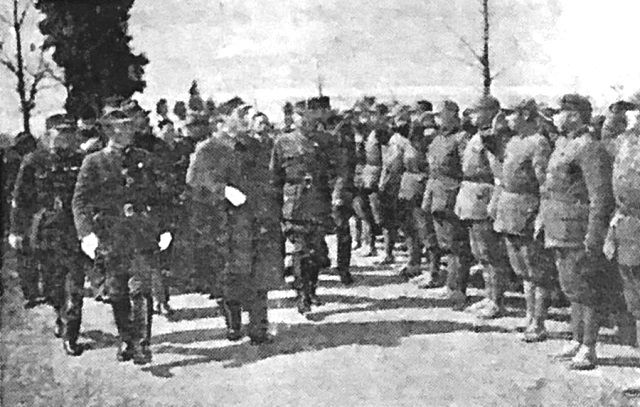 The Generalissimo, accompanied by Gen. Chien Ta Chaun, personal chief of staff; Lt. Gen. Tu Li-ming and Gen. Wei Li-huang, inspect troops
of the youth army.
The Generalissimo, accompanied by Gen. Chien Ta Chaun, personal chief of staff; Lt. Gen. Tu Li-ming and Gen. Wei Li-huang, inspect troops
of the youth army.
 The Generalissimo departing from the base of an East China Wing of the Fourteenth Air Force, where he was welcomed by Col. Clayton B. Claassen,
wing commander. The Generalissimo spoke to the men an praised their accomplishments in the China war.
The Generalissimo departing from the base of an East China Wing of the Fourteenth Air Force, where he was welcomed by Col. Clayton B. Claassen,
wing commander. The Generalissimo spoke to the men an praised their accomplishments in the China war.
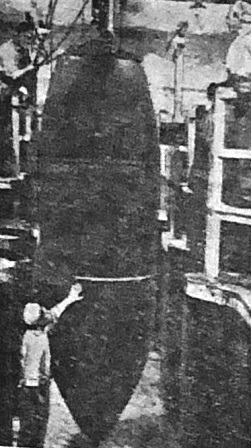 TEN TONNER - First photograph to reach China of the RAF's new ten-ton bomb. This one is just coming off the filling line.
TEN TONNER - First photograph to reach China of the RAF's new ten-ton bomb. This one is just coming off the filling line.
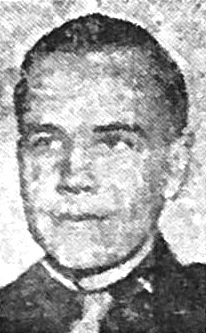
 A BY-PASS TO DIVERT VEHICLES arriving over the Burma Road around the ancient city walls, avoiding city traffic in Kunming, was recently opened
with due ceremony. Mrs. Charles Lin, wife of chief engineer, District 8, National Military Council, cut the red ribbon to open the eight-kilometer
bypass. She was assisted by her two daughters - Mei-Mei and San-San. Present also for the ceremony were Capt. Thomas H. Hopkins, Lt. Col. Ernest W. Everly,
Maj. Gen. G. X. Cheves, commanding general, Services of Supply; Mrs. Lin, Col. Joseph S. Gorlinski, China Theater engineer; Major Martin A. Nicholas and
Mayor T. Y. Lo of Kunming.
A BY-PASS TO DIVERT VEHICLES arriving over the Burma Road around the ancient city walls, avoiding city traffic in Kunming, was recently opened
with due ceremony. Mrs. Charles Lin, wife of chief engineer, District 8, National Military Council, cut the red ribbon to open the eight-kilometer
bypass. She was assisted by her two daughters - Mei-Mei and San-San. Present also for the ceremony were Capt. Thomas H. Hopkins, Lt. Col. Ernest W. Everly,
Maj. Gen. G. X. Cheves, commanding general, Services of Supply; Mrs. Lin, Col. Joseph S. Gorlinski, China Theater engineer; Major Martin A. Nicholas and
Mayor T. Y. Lo of Kunming.
 EVACUEES - Happy over good fortune, Army nurse Lt. Anna Louise Bonner-Pardew of Portland, Ore., and daughter Oliver Jane, hugging panda,
arrive at Hamilton Field, Calif. For three years they were prisoners of Japs.
EVACUEES - Happy over good fortune, Army nurse Lt. Anna Louise Bonner-Pardew of Portland, Ore., and daughter Oliver Jane, hugging panda,
arrive at Hamilton Field, Calif. For three years they were prisoners of Japs.
 TRANSPORTATION - Pack horses bringing commodities in from the north-west.
TRANSPORTATION - Pack horses bringing commodities in from the north-west.
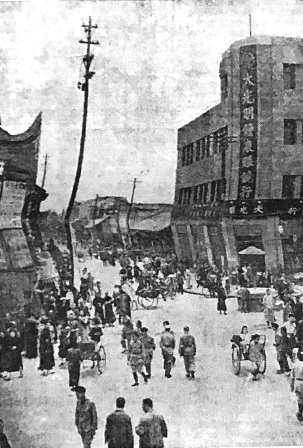 SOUTH END OF SCHUEN SHE ROAD at the intersection of Chung Foo Street, looking west on Chung Foo.
SOUTH END OF SCHUEN SHE ROAD at the intersection of Chung Foo Street, looking west on Chung Foo.
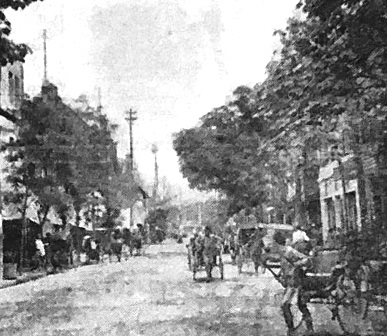 SCHUEN SHE ROAD, principle shopping street of Ch'eng-tu.
SCHUEN SHE ROAD, principle shopping street of Ch'eng-tu.
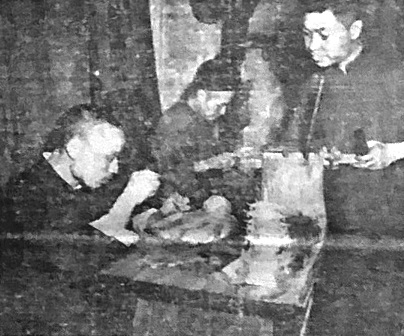 A PRINCIPLE CRAFT IN CH'ENG-TU is the making of articles of silver. Here a craftsman is seen at work in one of the larger shops.
A PRINCIPLE CRAFT IN CH'ENG-TU is the making of articles of silver. Here a craftsman is seen at work in one of the larger shops.
